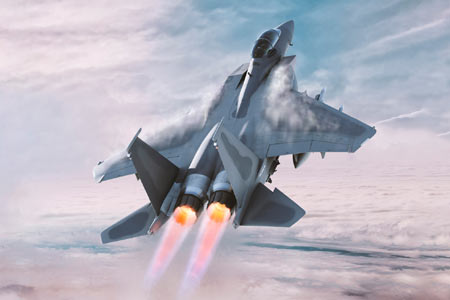- +91-8624883983
- info@insightsmicro.com
Military Aerospace And Defense : Trending Facts & Insights

The Defense Aviation and Space Industry also refers to the industry that deals with the development of aircraft, space vessels, and weapons that are specified for the needs of the armed forces of a particular nation, national defense and security force, as well as security services. The industry consists of government legislation, defense purchases, and security threats that shape its growth.
Market Value: As of 2025, the market size of the global military aerospace and defense industry is estimated at around 400 billion USD, and it is anticipated to attain 550 billion USD by 2030 as the growth rate of the market is set at a compound annual growth rate of 5.8 percent. The primary drivers of this growth are the increasing demand for advanced combat aircraft, the expansion of the UAV market, and the proliferation of missile defense systems.
Global Military Aerospace and Defense Industry
Overview
The Defense Aviation and Space Industry also refers to the industry that deals with the development of aircraft, space vessels, and weapons that are specified for the needs of the armed forces of a particular nation, national defense and security force, as well as security services. The industry consists of government legislation, defense purchases, and security threats that shape its growth.
Market Value: As of 2025, the market size of the global military aerospace and defense industry is estimated at around 400 billion USD, and it is anticipated to attain 550 billion USD by 2030 as the growth rate of the market is set at a compound annual growth rate of 5.8 percent. The primary drivers of this growth are the increasing demand for advanced combat aircraft, the expansion of the UAV market, and the proliferation of missile defense systems.

Types & Definition
The army aerospace and defense industry identifies the concepts of design, development, production, and management of both aircraft and spacecraft as well as weaponry and defense systems meant for only military purposes. This sector is also highly regulated by various governments because of the contracts they award together with any concomitant international cultural and security politics.
1. Streamlined and updated vehicles, such as certain models of combat aircraft like the Su-57 and F-35 fighters, or bombers like the Tu-160
2 Spirits, are used to confront enemies.
3. Air Transport and Observation Services: Includes cargo transport utilities as the production of armed forces for air transportation like the C-130 Hercules, and currently advanced aircraft reconnaissance is the primary mission.
4. Anti-Aircraft Units, including Missiles: Examples: Patriot Anti-Missile Systems, Hypersonic Lasers, and other constituents of Strategic Defense.
5. UAVs (Unmanned Aerial Vehicles): such as the Predator or Global Hawk; this category also includes all other tactical uses of UAVs.
6. E-War and Cyber Protection: This is a category that will include these technological advances in radar jamming cyber attacks and SIGINT.
7. as well as in Space and Underwater Systems: Long-ranged maritime strike and anti-submarine countermeasures against spacecraft.
Industry Trends
Entrance of Multi-role Fighters: Countries prefer versatile fighters that can operate in multiple combat environments.
The utilization levels of Unmanned Aerial Vehicles (UAVs) are increasing due to their use in intelligence gathering, active combat, and territory monitoring.
Emergence and Growth of Private Militant Industries Aiding Militaries – It is common to see companies like SpaceX engaging in projects within the military sphere, such as space and defense.
Progress in Stealth Technologies: Research is moving towards developing techniques and materials that can be applied to aircraft as well as submarines and their paints for a stealth effect.
Programs of Military Renovation: Old airframes and weapons are being replaced with the next generation of combat aircraft and weapons.
Facts & Insights
AI and Automation: These systems consist of AI-powered drones and self-armed robots that elevate the level of warfighting.
Hypersonic Weapons: Research and development in Russia, the United States, and China has spurred a new wave of investments in hypersonic missiles capable of evading defense systems.
Space Militarization: Countries are demilitarizing space with a satellite defense system and ASAT weapons in an attempt to militarize outer space.
Green Defense Initiatives: Apart from that, in the 'green' concepts, there appeared environmentally friendly military aircraft that use alternative forms of fuel and technologies like radar and propulsion.
Cyber Defense Prioritization: As digital threats increase, military organizations are focusing tremendously on building suitable cyber defense systems.
Market Segment
1. By Platform:
- Aircraft defense (fighters, drones, and transport)
- Ground defense (missiles, rugged vehicles + anti-air system)
- Maritime defense (carrier jets as well as systems for submarines)
- Main defense ( satellite , reconnaissance )
2. By Region:
North America, specifically the USA, is the region with the highest military spending.
Europe, along with France, the United Kingdom, and Germany, are leading countries in modernizing their air forces.
Asia Pacific (China and India are catching up in terms of preparing for space wars or a nuke war)
Middle East & Africa (which also has increased and continues to do so with military spending)
Industry Leader
- Lockheed Martin: Top F-35 Lightning II jet and anti-missile systems developer.
- Boeing Defense & Security: Does the production of F/A-18, Apache helicopters, as well as military satellites.
- Northrup Grumman: Manufacturer of B-21 Raider and provides cyber defense systems.
- Advanced Raytheon Technologies: They are the major contractor of missile defense as well as electronic warfare.
- General Dynamics: Manufactures smart weapon systems, stealth submarines, and internet-based crime prevention devices and services.
BAE Systems is a large European defense contractor that manufactures Typhoon fighter jets and ship defense systems.
Airbus Military & Aerospace: Provided cargo airplanes for armed forces and a defense system consisting of satellites.